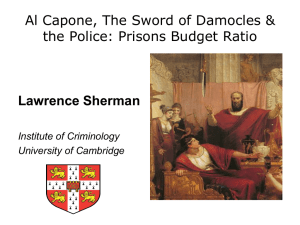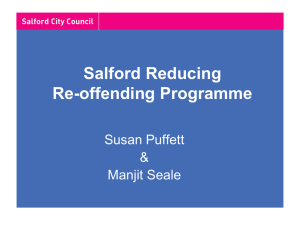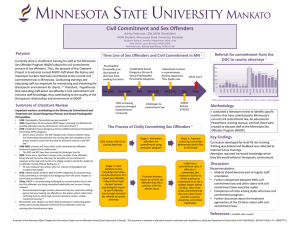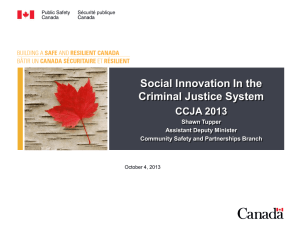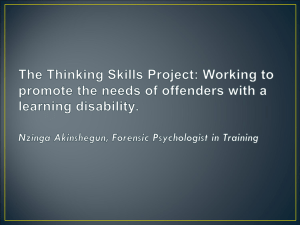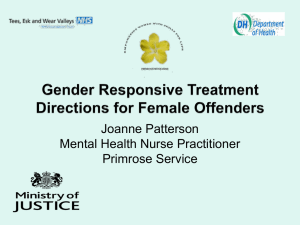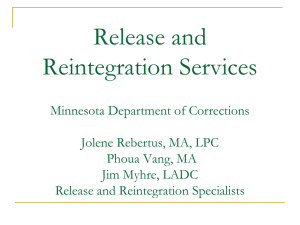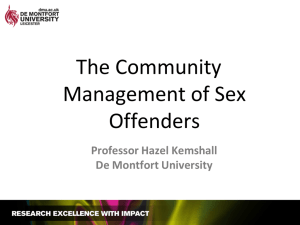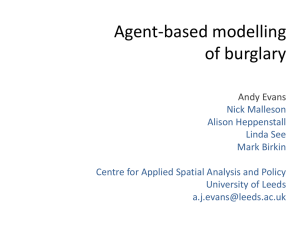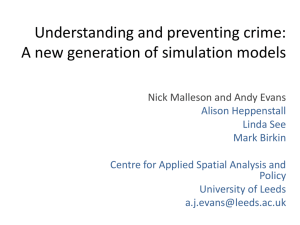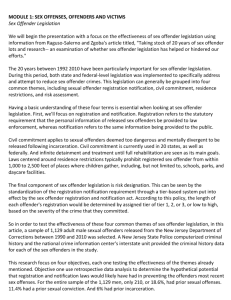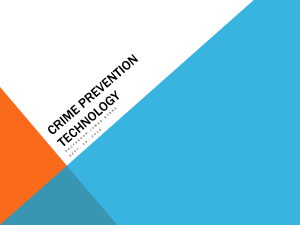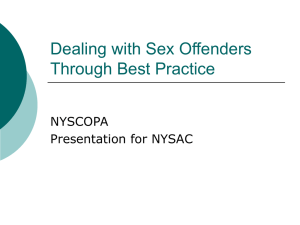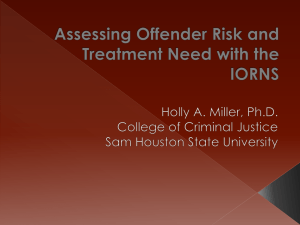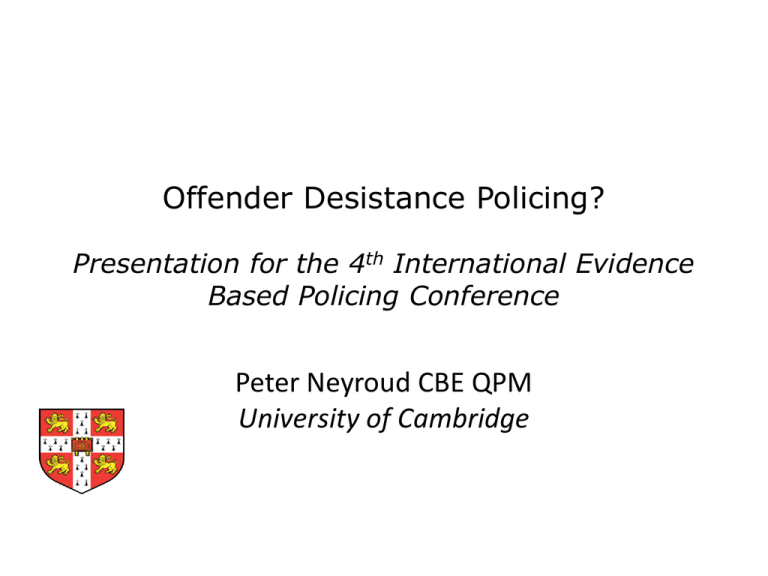
Offender Desistance Policing?
Presentation for the 4th International Evidence
Based Policing Conference
Peter Neyroud CBE QPM
University of Cambridge
Overview
• An outline of the theory
• Turning theory into practice: a programme of
experiments
• The implications for practice
Context
• Pressure on criminal justice budgets
• Renewed emphasis on prevention and
rehabilitation
Life course criminology
• Growing understanding from key work such as
the prizewinners, Sampson and Laub
• Desistance as a process with turning points
• Opportunities to focus on encouraging
desistance amongst the known offenders
• Particularly the “power few” who are
persistent
• But also to prevent others joining them
Crime Harm Forecasting
• Since Meehl 1954 Clinical Versus Statistical
Prediction
• Statistical Prediction beats Clinical
• Most contests before statistical learning
• Cheap supercomputers
• “Data mining” that assays every possible
pattern of precursors
• Identifies best prediction combinations
New Generation of Risk Forecasting
• Based only on Prior
Charges, Residence, Age,
Sex—no PSR
• Nothing qualitative
• More like a short-term
weather forecast
• Based on huge samples
• E.g., 30,000 in Philadelphia
• Journal Royal Statistical
Society, Series A, 2009
Richard Berk
Geoffrey Barnes (2007) 2-Year Berk Forecast Test,
Philadelphia APPD Cases
High Risk (2%)
Neither High nor
Low Risk (38%)
Low Risk (60%)
Effects of Prosecution and Prison on
recidivism
• “almost all of the results are negative in direction, as
measured by prevalence, incidence, severity, and selfreport outcomes.” Petrosino et al. (2010)
• “Growing research evidence suggests that for many if
not most people put in prison for the first time, the net
effect of prison may be to cause more crime than if the
sentence had not been custodial” Sherman and
Neyroud (forthcoming)
• The deterrent effects of Prosecution and Incarceration
are balanced by potentially negative treatment effects,
particularly for first time entrants
Certainty and Celerity not Severity: a
cause for HOPE?
• Operation HOPE focused on recidivist drug
offenders
– Emphasis on certainty of punishment if treatment
conditions breached
– Trial showed a near halving of overall incarceration
rate
• HOPE is being replicated in 2 mainland sites and
results appear consistent
• HOPE appears to be effective with lower risk
offenders
Offender Focused policing
• Police can replicate many of the preventive
effects of HOPE but before prosecution
• For example, Restorative Justice experiments
(Sherman and Strang) demonstrated positive
effects in reducing violent reoffending (less
effective with property offenders
The Sword of Damocles
• 2 Experiments in Omaha, Nebraska testing
different approaches to domestic violence
(Dunford et al. 1990).
• “These experiments found that the mere
issuance of a warrant for an offender’s arrest had
a greater deterrent effect than actually arresting
the offender”
• The more general form of this proposition is that
by communicating more certainty that some
action will be taken, police may able to prevent
many offences from occurring
A Programme of experiments
• Stage One: constructing a Crime Harm Index
• Stage Two: First Time Offender diversion to
offender desistance policing
• Stage Three: applying the CHI as a triage tool
in police custody suites
• Stage Four: testing which tactics produce the
best
The Crime Harm Index
• A random sample of 100,000 records from the
UK Police National Computer’s Phoenix
criminal records database
• Produces over 3,000,000 data items about the
100,000 offenders
• Replicating Berk’s model with the larger
database
• Using statistical analysis to model the factors
predicting serious harm
First Time Offender trial
• Taking a sample of offenders whom the police
have decided to prosecute
• Who have no previous conviction (they may
have previous cautions or other diversions)
• Randomly assigning them to prosecution or
police offender management
• Developing a standard protocol of tactics for
police offender management linked to “sword
of Damocles” approach
A Triage tool for custody officers
• From the CHI work with the Police National
Computer, developing a triage tool to guide
custody decisions about investigation,
prosecution and diversion
• Applying that tool in a further trial linking
police offender management to CHI triage
• Measuring the outcome against an index of
crime harm
Testing the tactics
• In the later trials, testing the relative benefits
of different elements of the protocol of tactics
against each other
• Matching interventions more effectively to
offenders
• Experimenting with Community, volunteer
and other agency support for the tactics
Conclusions
• “It is entirely possible that all of these tactics could fail
to foster desistance from crime, even though the
strategy of diversion or harm-forecasting could work
nonetheless. There may be more general validity
finding by Petrosino and his colleagues (2010) that
doing nothing with juveniles was better than doing
something, at least in terms of repeat offending. Yet it
is very difficult to reconcile doing nothing with deeply
held moral values for holding offenders accountable.
Whatever works in terms of helping offenders desist
should also be seen as a form of justice, one by which
offenders must pay a price.” Sherman and Neyroud,
forthcoming


